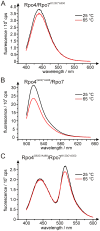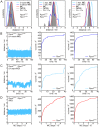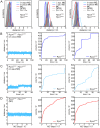Simulation vs. reality: a comparison of in silico distance predictions with DEER and FRET measurements
- PMID: 22761805
- PMCID: PMC3382601
- DOI: 10.1371/journal.pone.0039492
Simulation vs. reality: a comparison of in silico distance predictions with DEER and FRET measurements
Abstract
Site specific incorporation of molecular probes such as fluorescent- and nitroxide spin-labels into biomolecules, and subsequent analysis by Förster resonance energy transfer (FRET) and double electron-electron resonance (DEER) can elucidate the distance and distance-changes between the probes. However, the probes have an intrinsic conformational flexibility due to the linker by which they are conjugated to the biomolecule. This property minimizes the influence of the label side chain on the structure of the target molecule, but complicates the direct correlation of the experimental inter-label distances with the macromolecular structure or changes thereof. Simulation methods that account for the conformational flexibility and orientation of the probe(s) can be helpful in overcoming this problem. We performed distance measurements using FRET and DEER and explored different simulation techniques to predict inter-label distances using the Rpo4/7 stalk module of the M. jannaschii RNA polymerase. This is a suitable model system because it is rigid and a high-resolution X-ray structure is available. The conformations of the fluorescent labels and nitroxide spin labels on Rpo4/7 were modeled using in vacuo molecular dynamics simulations (MD) and a stochastic Monte Carlo sampling approach. For the nitroxide probes we also performed MD simulations with explicit water and carried out a rotamer library analysis. Our results show that the Monte Carlo simulations are in better agreement with experiments than the MD simulations and the rotamer library approach results in plausible distance predictions. Because the latter is the least computationally demanding of the methods we have explored, and is readily available to many researchers, it prevails as the method of choice for the interpretation of DEER distance distributions.
Conflict of interest statement
Figures








Similar articles
-
Cross-validation of distance measurements in proteins by PELDOR/DEER and single-molecule FRET.Nat Commun. 2022 Jul 29;13(1):4396. doi: 10.1038/s41467-022-31945-6. Nat Commun. 2022. PMID: 35906222 Free PMC article.
-
Structural refinement from restrained-ensemble simulations based on EPR/DEER data: application to T4 lysozyme.J Phys Chem B. 2013 May 2;117(17):4740-54. doi: 10.1021/jp311723a. Epub 2013 Apr 11. J Phys Chem B. 2013. PMID: 23510103 Free PMC article.
-
Full Atom Simulations of Spin Label Conformations.Methods Enzymol. 2015;563:623-42. doi: 10.1016/bs.mie.2015.07.030. Epub 2015 Sep 11. Methods Enzymol. 2015. PMID: 26478501 Free PMC article.
-
Going the dHis-tance: Site-Directed Cu2+ Labeling of Proteins and Nucleic Acids.Acc Chem Res. 2021 Mar 16;54(6):1481-1491. doi: 10.1021/acs.accounts.0c00761. Epub 2021 Jan 21. Acc Chem Res. 2021. PMID: 33476119 Review.
-
Integrating Electron Paramagnetic Resonance Spectroscopy and Computational Modeling to Measure Protein Structure and Dynamics.Chempluschem. 2024 Jan;89(1):e202300506. doi: 10.1002/cplu.202300506. Epub 2023 Oct 25. Chempluschem. 2024. PMID: 37801003 Review.
Cited by
-
Conformational States of Cytochrome P450 Oxidoreductase Evaluated by Förster Resonance Energy Transfer Using Ultrafast Transient Absorption Spectroscopy.Biochemistry. 2016 Nov 1;55(43):5973-5976. doi: 10.1021/acs.biochem.6b00623. Epub 2016 Oct 19. Biochemistry. 2016. PMID: 27741572 Free PMC article.
-
Sub-millisecond conformational dynamics of the A2A adenosine receptor revealed by single-molecule FRET.Commun Biol. 2023 Apr 3;6(1):362. doi: 10.1038/s42003-023-04727-z. Commun Biol. 2023. PMID: 37012383 Free PMC article.
-
Advanced FRET normalization allows quantitative analysis of protein interactions including stoichiometries and relative affinities in living cells.Sci Rep. 2019 Jun 3;9(1):8233. doi: 10.1038/s41598-019-44650-0. Sci Rep. 2019. PMID: 31160659 Free PMC article.
-
Cross-validation of distance measurements in proteins by PELDOR/DEER and single-molecule FRET.Nat Commun. 2022 Jul 29;13(1):4396. doi: 10.1038/s41467-022-31945-6. Nat Commun. 2022. PMID: 35906222 Free PMC article.
-
Automated and optimally FRET-assisted structural modeling.Nat Commun. 2020 Oct 26;11(1):5394. doi: 10.1038/s41467-020-19023-1. Nat Commun. 2020. PMID: 33106483 Free PMC article.
References
-
- Edidin M. Fluorescence resonance energy transfer: techniques for measuring molecular conformation and molecular proximity. Curr Prot Immunol Chapter 18: Unit 18.10. 2003. - PubMed
-
- Schiemann O, Prisner TF. Long-range distance determinations in biomacromolecules by EPR spectroscopy. Q Rev Biophys. 2007;40:1–53. - PubMed
-
- Bordignon E, Steinhoff HJ. Membrane protein structure and dynamics studied by site-directed spin labeling ESR. In ESR Spectroscopy in Membrane Biophysics, Hemminga, M. A., Berliner, L. J., Eds.; New York: Springer Science and Business Media. Pp. 2007. pp. 129–164. - PubMed
-
- Förster T. Transfer mechanisms of electronic excitation. Discuss Faraday Soc. 1959;27:7–17.
Publication types
MeSH terms
Substances
Grants and funding
LinkOut - more resources
Full Text Sources

